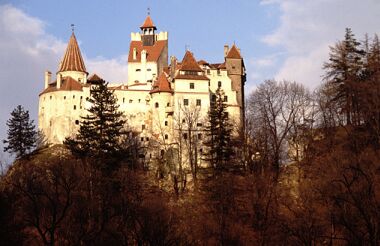Bran Castle

Bran Castle, situated near Braşov in Romania, is a national monument and landmark. It was built by the Teutonic Knights in (or around) 1212, after they had been relocated from Palestine to the Kingdom of Hungary.
The fortress is situated on the border between Transylvania and Wallachia, on Highway 73. In addition to its unique architecture, the castle is famous because of persistent myths that it was once the home of Vlad the Impaler, a famous or infamous medieval warlord; however, there is no evidence that he ever lived there. According to most accounts, the Impaler spent two days in the Bran dungeon, as the area was occupied by the Ottoman Empire at the time. Because of the (disputed) connections between Vlad and the fictional character Dracula, the castle is marketed to foreign tourists as Dracula's Castle; see below.
The castle is open to tourists, who can view the inside by themselves or as part of a guided tour. At the bottom of the hill is a small park to which examples of traditional Romanian peasant structures (cottages, barns, etc.) from across the country have been moved.
The castle passed through royal hands for many generations. For many years at the beginning of the C20, it was the principal home of Queen Marie, who, despite her British birth and upbringing, became quite a Romanian patriot. The castle is decorated largely with artifacts from her time, including traditional furniture and tapestries that she collected to highlight Romanian crafts and skills. It was inherited by her daughter Princess Ileana of Romania, and was later seized by the Communist government of Romania in 1948. For many years it was tended to erratically, but after 1980s restoration and the Romanian Revolution of 1989, it became a tourist destination. The legal heir of the castle is the Princess's son Dominic von Habsburg and in 2006 the Romanian government returned it to him (Habsburg is an architect in New York City).
 "Dracula's Castle"
"Dracula's Castle"Allegedly, Bram Stoker, who fashioned portions of his character Count Dracula based on aspects of Vlad the Impaler, used Bran Castle as his model for Dracula's castle. Bran Castle was subsequently featured in multiple film adaptations of Dracula, and has informally become known as Dracula's Castle. The local economy has made use of the connection to boost tourism; a small market exists at the castle gates selling every imaginable article connected with, or depicting the portrait of, Dracula and vampires.

0 Comments:
Post a Comment
<< Home